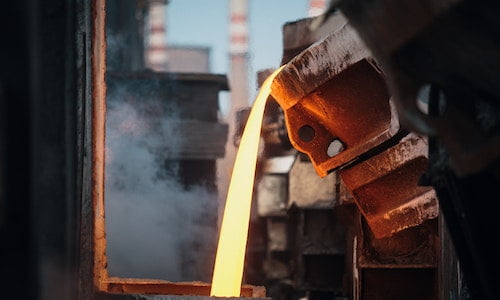For heat treatment in inert atmospheres, an atmosphere furnace is widely used in industrial and laboratory research settings. To allow vacuum and gas purging, these furnaces have necessary components such as a vacuum pump, gas flow meter, and needle valves. Gasses such as Argon (Ar) and Nitrogen (N2) are commonly used to create inert atmospheres. Specific atmosphere furnaces are constructed with additional safety measures to prevent dangerous explosions in applications utilizing hydrogen gas. In such cases, these precautions ensure that the furnace operates safely.
The environment furnace uses a rotary vane oil-filled vacuum pump to create a modest vacuum which is then followed by the purging of inert gasses like Argon or Nitrogen. Materials, mainly metals and ceramics, are contained in an environment of Argon or Nitrogen gas during this procedure to prevent the production of oxides. These inert atmosphere furnaces are used for a variety of procedures, including annealing, brazing, and heat treatment of oxidizable materials.
Features and benefits of atmosphere furnaces:
- Wide Temperature Range: The atmosphere furnace is available in temperature options of 1200°C, 1400°C, and 1700°C, providing versatility for various heat treatment applications.
- Controlled Inert Gas Atmosphere: The furnace ensures a fully controlled inert gas atmosphere under vacuum conditions. This feature allows for precise control over the environment surrounding the materials being treated.
- Excellent Gas Sealing: The atmosphere furnace has an efficient door-sealing mechanism that minimizes inert gas leakage. This component maintains the integrity of the ideal atmosphere within the boiler, ensuring a controlled environment and preventing any undesired contamination.
- Programmable Temperature Controller: The atmosphere furnace is equipped with a programmable temperature controller, allowing users to set and adjust temperature profiles according to their specific heat treatment requirements. With the inclusion of ramp and soak facilities, precise temperature management is achieved, ensuring optimal control and customization of the heat treatment process within the furnace.
- Door Safety Limit Switch: To ensure safety during operation, the furnace incorporates a door safety limit switch. This feature automatically turns off the heater when the door is open, preventing accidental exposure to high temperatures.
- Oil-Filled Vacuum Pump: The atmosphere furnace is equipped with an oil-filled vacuum pump, accompanied by a silicone rubber pipe. This combination enables efficient and reliable vacuum generation, crucial for creating the desired atmosphere.
- High-Purity Fibrous Alumina Insulation: The furnace features high-purity fibrous alumina insulation, which offers excellent thermal insulation properties. This insulation ensures minimal heat loss and enhances the energy efficiency of the furnace.
- Double-Walled Steel Structure: The furnace is built with a double-walled steel structure, providing durability and structural integrity. Additionally, fan cooling is incorporated to enhance heat dissipation and maintain a stable temperature inside the furnace.
- Gas Mixing Channel (Optional): The atmosphere furnace can be equipped with a gas mixing channel. This allows for precise control and adjustment of gas composition within the furnace, enabling tailored atmospheres for specific heat treatment processes.
These features and benefits make atmosphere furnaces reliable, efficient, and versatile tools for various heat treatment applications, providing controlled environments to achieve desired material properties and quality.
High Temperature Furnace
High temperature furnace are specialized laboratory furnaces designed to achieve exceptionally high temperatures ranging from 1400°C up to 1800°C, surpassing the capabilities of standard furnaces.
These furnaces are used in a variety of procedures, including sintering high-temperature materials, glass melting, high-temperature ceramic testing, fusion and firing processes, and powder metallurgy processes. Because of their ability to attain and maintain extremely high temperatures, they are vital equipment for advanced material research, testing, and production in industries that require high-temperature applications.
Atmosphere furnaces play a significant role in heat treatment processes conducted under inert atmospheres in industrial and laboratory research settings. They are equipped with essential components like vacuum pumps, gas flow meters, and needle valves to facilitate vacuum and gas purging. By utilizing gasses such as Argon and Nitrogen, these furnaces create controlled inert atmospheres that prevent oxide formation during heat treatment.

